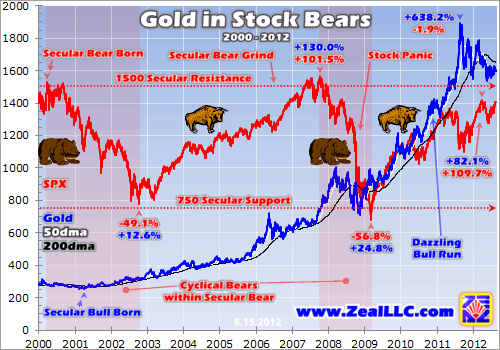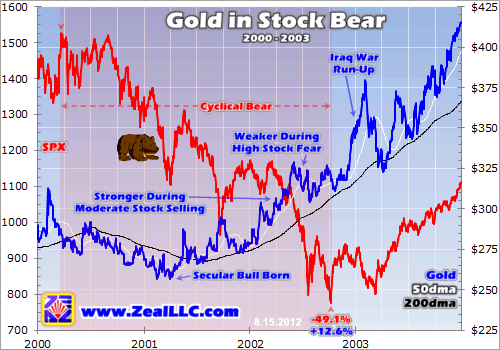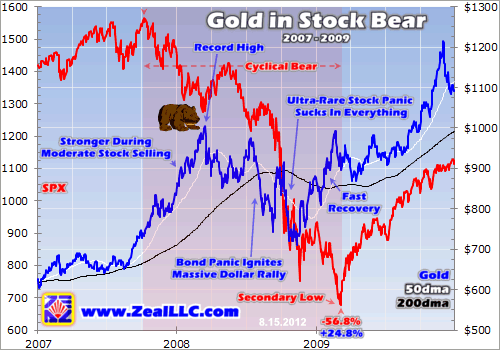|
|
|||||||
|
|
|
|
|
|
|
|
|
|
Gold in Stock Bears Adam Hamilton August 17, 2012 2889 Words
With the odds for a new stock bear growing, prudent contrarian investors are looking for bear-resistant destinations for their hard-earned capital. Plain old cash tops the list, as it will not only preserve wealth but increase its relative stock buying power as the markets grind lower. But why merely sideline capital if it can still be grown even during a stock bear? Gold has proven its ability to thrive in such markets.
Last week I wrote an essay on the rising chances a new stock bear is looming. This primarily has to do with the bull-bear cycles. The stock markets endlessly march forward in a series of alternating bulls followed by bears. After a bull, a bear is pretty much inevitable. This is true at both scales of the bull-bear cycles, the great decade-plus secular moves and the smaller multi-year cyclical moves within them.
Our latest stock-market cyclical bull that was born back in early 2009 is long in the tooth. It is both older and larger than average for mid-secular-bear cyclical bulls. This means a new cyclical bear is increasingly likely. And since these fearsome beasts tend to maul general stock prices until they are cut in half over a couple years, they are not to be trifled with. Gold offers a great way to weather them.
And this assertion isnít just theoretical. Over the past decade or so weíve suffered through no fewer than three major bear markets in stocks. They all wreaked vast damage on both stock prices and investor sentiment. Yet gold prices still continued advancing on balance even in the face of rotten general-stock psychology. This metal is a battle-hardened veteran of many stock bears, thriving in general adversity.
And if gold could keep on rallying during past stock bears, thereís no reason not to expect this contrary behavior to persist in the next one. Goldís secular bull remains very much alive and well, enjoying strong supply-and-demand fundamentals. On top of this, the worldís central banks continue to flood the globe with rapidly-inflating fiat currencies. So relatively more money will continue chasing relatively less gold.
The primary driver of goldís entire secular bull, and every major upleg within it, is global investment demand. And when everything else is selling off, which is what happens during stock bears, gold becomes a lot more attractive to investors. Capital follows performance, so this metalís relative strength in times when little else is rallying is irresistible. With few alternatives, goldís investment demand surges.
Goldís strong investment-demand-driven performance during past stock bears is easiest to digest visually. Our charts this week superimpose gold over the flagship S&P 500 stock index (SPX) during each of the three major stock bears of this past decade or so. As youíll see, this metal has proven its ability to rally even when general stocks are mired deep in brutal bear markets. Gold performs when little else does.
The biggest and most important stock bear to consider is the secular monster that started way back in March 2000. It is over 12 years old now, but these incredible beasts tend to persist for 17 years each. For more background on why, get up to speed on the Long Valuation Waves. Secular bears are not periods of declining stock prices, but long sideways grinds. They give earnings time to catch up with stock prices.
Over a dozen years after the SPX first hit 1500, it still has yet to materially exceed its preceding secular bullís top. The implications of this are staggering for investors. At best we each have about four decades to build wealth, from roughly the ages of 25 to 65. So a full secular bear can rob unwary investors of nearly half of their entire investing lifespans! Stock markets not only donít advance, but actually lose ground in purchasing-power terms thanks to inflation.
A buy-and-hold stock investor, which was considered the pinnacle of wisdom in early 2000, isnít even back to break-even yet after over a decade. What a tragedy and waste! Incidentally I started warning investors about the risk of a 17-year sideways grind way back in 2001, when there was plenty of time to avoid it. Instead I advocated gold, which was loathed then after suffering a multi-decade secular bear.
Goldís bear bottomed in early 2001, stealthily yielding to what would become a mighty secular bull. And between April 2001 and its best levels so far in August 2011, gold would power a breathtaking 638% higher! How did the stock markets do over this same secular timeframe as measured by the flagship SPX? Down 2%. Gold has been, hands down, the best investment of this entire secular stock bear.
While goldís awesome secular bull made prudent contrarian investors like our subscribers rich over the past decade while mainstream investors earned nothing, it is not the secular we are interested in today. Instead it is the cyclical. The giant sideways grind of secular stock bears is formed by an alternating series of cyclical bears and bulls. After cyclical bears cut stocks in half, cyclical bulls double them again.
As you can see above, our current secular stock bear since 2000 has seen two cyclical bears (highlighted in red) and two cyclical bulls. The former hammer stocks down near their secular support at SPX 750, half the level of the preceding secular-bull highs. And then the latter catapult stocks back up near the SPXís 1500 secular resistance. Thus cyclical bears and bulls define the secular bearís long trading range.
The performances of the SPX and gold over the exact spans of each cyclical stock bear and bull are noted on this chart. The first cyclical bear running from March 2000 to October 2002 saw the SPX lose 49.1%, get cut in half. But even though goldís secular bull wasnít born until the middle of this stock bear, the yellow metal still rallied 12.6%. Provocatively that initial cyclical stock bear probably ignited goldís secular bull in the first place.
After bouncing near 750 in October 2002, the SPX began powering higher in a new cyclical bull. It would ultimately surge 101.5% higher by October 2007. With stocks doing so well, gold must have suffered right? Surely investors turned away from it to chase more mainstream investments. But incredibly, gold actually outperformed the SPX handily even during this doubling stock bull. The metal surged 130.0%!
The second cyclical bear of the stock marketsí secular bear was born in October 2007. But it was no ordinary bear, ultimately culminating in an ultra-rare stock panic. Even though the SPX lost a staggering 56.8% by the post-panic secondary low in March 2009, gold rallied 24.8%. Iíll delve into goldís performance in each of these cyclical bears more deeply below, as it was truly quite impressive.
After that the second cyclical bull of this secular bear began marching higher, reaching 109.7% gains in the SPX by its latest interim high in early April 2012. While gold couldnít manage to best the stock markets again, it certainly held its own with a very respectable 82.1% gain over this span. Gold has been the go-to investment of this entire secular stock bear, rallying through cyclical bears and bulls alike!
Now despite gold investment demand growing during cyclical stock bears when little else is rising, you no doubt noticed its cyclical-bear performance was far inferior to its cyclical-bull performance. Why? Psychology. The fortunes of the stock markets dominate sentiment, both among investors and speculators and out in the broader populace. The SPXís performance even effectively decides presidential elections!
When the stock markets are mired in a cyclical bear, naturally traders get depressed. Sentiment waxes darker and darker as the bear wipes out more capital, leaving speculators less willing to take risks. Unfortunately this bleeds into gold, which is still viewed by most mainstream traders as a highly-speculative asset. This antiquated worldview is rather inexplicable after goldís tremendous decade-plus bull run.
So while investment demand for gold grows during stock bears, speculative demand wanes. The hot money looking for fast gains is either getting crushed in falling general stocks or hiding out in cash or Treasuries. The rotten psychology spawned by stock bears universally dampens speculation. And without speculators making occasional big bets on gold, investment demand alone canít drive fast gains.
Zooming in to the individual cyclical stock bears, you can definitely see periods of time where excessive stock fear weighed on gold. This first chart looks at the first cyclical bear of the past decadeís secular stock bear, which ran from March 2000 to October 2002. Though the SPX was cut in half, a devastating loss for buy-and-hold investors, gold climbed by an eighth even though its secular bull had barely begun.
It is really provocative that gold bottomed just after the first serious selloff of this entire secular stock bear. With the SPX crumbling at a rate the majority of stock investors had never even witnessed after a multi-decade secular bull, capital started flowing into gold again as a safe haven. Investors were looking for an alternative, and a handful of contrarians like me were calling for a massive new secular commodities bull.
Goldís initial tentative advance in 2001 and 2002 tended to be stronger during moderate stock-market selling. Despite how steep the cyclical bears look in these charts, realize they unfold gradually over a couple years or so. Thus most of the time the fear levels in the stock markets arenít particularly high. The slow grind lower gives embattled stock investors plenty of time to migrate capital into the cheap gold market.
But in mid-2002 as the stock bear accelerated and neared its climax, fear skyrocketed. Gold stalled out during these particularly sharp selloffs. This is an important lesson for our next cyclical stock bear. While gold can rally just fine on balance while stock prices drift lower, major sharp selloffs can ignite so much fear that it temporarily scares investors away. Everyone hunkers down in cash and Treasuries until the fear passes.
Sometimes, like during 2008ís crazy stock panic, stock fear even gets extreme enough to suck gold into the selling frenzy. So hear me loud and clear on this. Just because gold tends to thrive in stock bears on balance doesnít mean it is an easy ride. Investors and speculators alike have to be prepared for high gold volatility at times, with this metal stalling or even sliding backwards if stock-market fear mushrooms great enough.
Still, given the choice between losing half of your capital in the stock bear, losing a few percent a year of purchasing power in cash due to inflation, or gaining an eighth in gold, sucking it up to deal with goldís occasional downside volatility is a small psychological price to pay. Just donít freak out when gold gets clobbered by rapidly falling stock markets, as such sentiment bleedover is merely a short-lived anomaly.
This principle of gold generally rallying but sometimes succumbing to stock fear continued in this secular bearís second cyclical bear. Once again this ran from October 2007 to March 2009, ultimately climaxing in a once-in-a-lifetime stock panic. But nevertheless, gold still did incredibly well through the greatest fear superstorm any investor alive today will ever see. Gold thrives even during the nastiest stock bears.
As the stock markets topped in late 2007 and started falling, gold surged dramatically. Early in stock bears nearly everyone believes they are merely pullbacks or corrections, so fear remains modest. As the SPX ground lower into early 2008, gold actually hit a record high in nominal terms. After this there was some profit taking as the SPX bounced, but once it started falling again gold resumed rallying on balance.
Gold was thriving in the last cyclical bear until the summer of 2008 when extraordinary things started happening. You may not remember this, but a couple months before the stock panic there was actually a bond panic. This ignited a massive US dollar rally that along with its later stock-panic component would grow into the biggest and fastest this currency has ever seen. The dollar soared on safe-haven demand.
And such an epic US dollar rally naturally weighed on gold. This metal is primarily priced in dollar terms and gold futures traders are very sensitive to dollar moves. While the first true stock panic in a century sucked in everything else, leading to previously unimaginable fear extremes, I suspect the skyrocketing dollar had more to do with goldís getting sucked in than general fear. The panicís gold impact was indirect.
Still, goldís performance during the height of the panic was far better than the stock marketsí. Over the worst single-month span of that brutal event, the SPX plummeted 30.0%. Nearly a third of Americansí collective stock wealth vaporized in weeks! Fear, as measured by the VXO fear gauge, surged into the high 80s. The normal ceiling for stock fear even in extreme selling events is merely around 50.
Yet despite this crippling fear, gold merely lost 16.7% over the scariest market month weíll see in our lifetimes. Iíd much rather own gold no matter how high fear gets, as it sells off slower and then rebounds quicker than general stocks. Note above that after the panic as the stock markets sank to new secondary lows on Obama fears, gold enjoyed a fast recovery. Investment capital continued to flow into this metal.
During a cyclical stock bear that climaxed in a once-in-a-century stock panic, the SPX lost a staggering 56.8%. Yet over this exact span, even given the serious selling pressure gold faced thanks to that epic panic-driven US dollar rally, gold still climbed 24.8% higher on balance. Would you rather lose over half in stocks, lose purchasing power in cash, or gain a quarter in gold? Gold thrives in stock bears.
Interestingly goldís best performance during both of this secular stock bearís cyclical bears was during the first halves. Remember that stock bears take a couple years or so to unfold, their selling arcs are gradual. The slower and more gradually a bear develops, the more investors it traps. Like the frog slowly brought to a boil, there arenít enough attention-grabbing warning signs to overcome the sheer complacency. So investors fail to sell stocks soon enough.
And if we are indeed nearing the next cyclical stock bear of this secular bear, its first half is likely to see gradual selling too. There arenít likely to be any super-sharp selloffs, nothing anywhere near fast enough to drive the VXO fear gauge up near 50. And it is in these early-bear environments, before stock fear thoroughly infects investors and speculators, that gold tends to thrive the most. This is great news.
In any new cyclical bear, we should get a year or so of this gradual early-bear selling. This is the perfect environment for gold, with the slow grind lower of the stock markets sparking increased investment demand for the yellow metal. So the downside risks in gold in the first halves of cyclical bears are much lower than in the second halves. It may even be practical to sell gold mid-bear and get into cash before the extreme fear-spiking late-bear selloffs arrive.
At any rate, gold tends to thrive during stock bears. With everything else falling, gold becomes particularly attractive. So investors gradually migrate into it even as speculators start to abandon it as the bearish psychology saps their courage to take risks. Gold still rallies on balance throughout cyclical stock bears even though stock prices are cut in half. These are wonderful returns in tough environments, far better than cash.
At Zeal we are preparing for the growing odds of a new cyclical stock bear. Weíve been shifting our capital into elite gold and silver stocks with outstanding fundamentals. While gold itself is low now technically and on the verge of its next major upleg, the beaten-down gold stocks are ridiculously cheap relative to todayís gold levels. Our trades are already marching higher even in the summer doldrums, and should start soaring as goldís major seasonal autumn rally soon accelerates.
You can mirror our trades in our acclaimed weekly and monthly subscription newsletters. Now is no time to hide your head in the sand and ignore your capital, as the risks and opportunities are great. And the only way to understand them is to always stay abreast of the markets. Our vast experience, knowledge, wisdom, and ongoing research distilled into our popular newsletters can help you do that. My web essays are only pieces of the puzzle, insufficient alone. To get the whole picture and start thriving, subscribe today!
The bottom line is gold thrives in stock bears. This metal has soared dramatically during the past decadeís secular bear, making prudent contrarian investors rich. And it has even rallied nicely during both of this secular bearís cyclical bears, tough periods where general stock prices were cut in half. Unlike anything else, gold has actually proven its ability to flourish in every modern bear market.
So though the old standby of holding cash during bears remains fine, goldís returns have been far superior. While fiat-currency inflation erodes the purchasing power of cash, gold rallies to substantial real gains even through the fiercest cyclical bears. And I sure doubt the next bear will prove any exception given goldís amazingly bullish fundamentals, technicals, and sentiment prevalent today.
Adam Hamilton, CPA August 17, 2012 Subscribe |
|||||||
|
|
|
|
|
|
|
|
|
|
|
|
|
|
|
|||



